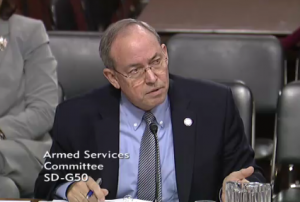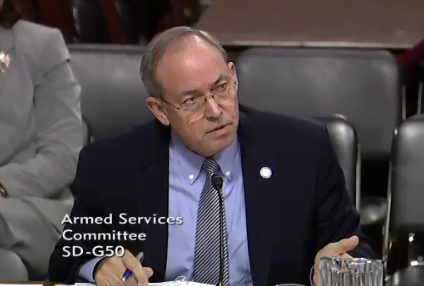2015-11-12 By Robbin Laird and Ed Timperlake
On November 5, 2015, Lt. General (Retired) Deptula testified in front of the Senate Armed Services Committee.
The key topic was the challenge of revisiting the roles and missions of the Armed Forces.
This is especially crucial because of the more than decade long legacy of fighting a niche style of land war.
The use of the military in Iraq and Afghanistan since 9/11 has been largely defined in terms of using the air and naval services to support ground forces doing Counter Insurgency Operations or COIN.
In the first decade of the 21st century, groupthink set into the Pentagon and resulted in COIN becoming dominant, to the point that other joint options were shut out from consideration.
The groupthink of COIN resulted in key elements of a fighting force being crafted in the image of COIN, with its slow motion warfare; hierarchical C2; the growth of the OOLDA (Observe, Orient, Legally Review, Decide, and Act) loop replacing a decisive, quick action OODA or Observe, Orient, Decide and Act loop; K-Mart type of logistics to support capabilities; significant numbers of Forward Operating Bases or FOBs in the battlespace; and all dependent on uncontested, permissible air space.
We are seeing the results of this “fallout” in the current operations in Syria and Iraq—an approach reflective of fighting the last war.

In his testimony, Deptula underscored that:
In the information age, we have to acknowledge that deploying large numbers of
American military forces onto foreign soil to nation-build, vice accomplish a defined mission and leave, is simply counter-productive to securing our goals and objectives.
Strategies centered upon occupation and attrition warfare expose vulnerabilities, invariably result in anti-American backlash and domestic disapproval, and often create destabilizing effects within the very state or region they are intended to secure.
He added that:
We must actively pursue and invest in options we can use to counter the increasingly advanced anti-access strategies and technologies our adversaries are likely to employ. Systems such as precision weapons and stealth aircraft projected incredible lethality at the end of the Cold War.
Those capabilities did not disappear.
They continued to advance and proliferate. One quarter of a century later, it is foolhardy to assume U.S. forces will be afforded freedom of action in future engagements. Our strategies, planning assumptions, acquisition programs, and training need to account for this reality.
Deptula Testimony SASC Nov 5 2015
The day after he gave testimony, we discussed his thoughts with regard to how to more effectively build out the integrated combat power crucial to 21st century challenges.
Question: What would you highlight in terms of key conclusions, which you put in front of the Committee with regard to shaping an effective way ahead?
Lt. General (Retired) Deptula: There are two main conclusions that were highlighted.
The first was that we should not focus simply on one medium of warfare.
If we want to maintain our position as the world’s sole superpower, for all the right reasons that we should, we need to have the strongest Army, Navy, Marine Corps, and Air Force in the world.
This isn’t about one service versus another. This is about keeping the unique capabilities the services provide, but to capitalize on the technologies that will allow us to accomplish and succeed in different ways than we have in the past.
We need to reevaluate the roles and functions of the services in the light of the information age, as opposed simply to adjusting the traditional approach of combined arms, industrial age warfare.
New technologies enable new concepts of operation that, in turn, allow new organization or constructs that allow for innovation. We can apply innovation to organizations just as much as we can apply them from technologies.
A key example of how new technologies—which are already here, and are at the same time still evolving—can provide for significant change in our concepts of operation, are fifth generation systems. Modern aircraft are no longer just replacements for what went before. Aircraft like F-22, F-35, LRSB, are not just “F’s” or “B’s.”
They are flying sensor-shooters.
For example, an F-35’s wingman doesn’t necessarily need to be another F-35. It could be an Aegis destroyer or an advanced land vehicle; we need to think about applying the capabilities that these aircraft now have resident in them today, to reworking how the joint force can operate tomorrow.
They should be viewed as information nodes in what can be constructed as an ISR-strike- maneuver-sustainment complex. These aircraft will become integral parts of a “combat cloud,” which inverts the paradigm of the way we think about these systems.
They’re not just airplanes for the sole purpose of shooting down another airplane; or for dropping bombs. They will form the basis of a much larger complex that if properly designed will pose an adversary an enormously challenging problem. If you take out several of these nodes, that will not affect the overall power of the combat cloud because the capabilities they provide will reroute among the other elements.
The underlying basis of what some have called the third offset strategy, will be the ubiquitous exchange and sharing of information in a seamless fashion, and that is what the real advantage of F-35, F-22, and eventually the LRS-B, bring to the equation. We are beginning to see that with how the F-22 is being used today in the Middle East.
The first combat uses of the F-22 were not to shoot down another airplane. There were used to conduct multiple tasks — ISR, strike, airborne warning, intercept, battle management, command and control. The F-22 essentially acts as a quarterback for all of the aircraft airborne and increases the situational awareness of the entire force.
Question: The power projection services are already innovating in ways not widely recognized as one thinks about force transformation, the Osprey for the USMC, and the F-22 for the Air Force, to cite two examples.
How might it be possible to get a broader analytical understanding of the innovation already inherent and resident in the force, rather than analysts simply coming up with suggestions for a future force structure, uninformed by the innovation already underway?
Lt. General (Retired) Deptula: Quite frankly, it’s by providing examples of innovation and exposing as many people to change already underway as possible. It’s getting the word out in ways that Second Line of Defense does, and hammering home over and over and over again until, folks open their minds to the potential of what these systems are actually capable of doing. Once we get them in the field, that potential gets actualized. That’s what happened with the F-22.
Today, the Joint Force Air Component Commander in Central Command rarely launches a force package into Syria without having an F-22 with the force. That’s because the F-22 enhances the entire effort. That is an example of change that has happened, but is not widely understood. The mid-grade pilots and their squadron and wing commanders who are experiencing these attributes of 5th generation capability will be crucial to the transformation already inherent with the F-22, and soon to be accelerated with the F-35, and later with the LRS-B.
Question: We will be going to the Langley AFB exercise with F-22s flying with Typhoons and with Rafales. All of these aircraft are a decade old in combat terms, and are now coming into their own; it takes time to reshape concepts of operations to work with new combat technology and that reworking then informs what comes next.
Does that make sense to you?
Lt. General (Retired) Deptula: It does.
The coming of the F-35 is a good case in point.
All the naysayers on the F-35 challenge it for all the wrong reasons.
They challenge it on the basis of a last century concept of operations as opposed to thinking about the next round of innovation of which it will be an integral element.
Question: You were one of the key architects for Desert Storm in 1991. How would characterize the impact of the allies being on the ground floor with the F-35 and how they can play a role different from 1991?
Lt. General (Retired) Deptula: In Desert Storm, allies were important for many reasons, but on the military side provided limited, and very specialized contributions. With an allied F-35 fleet we can work from the ground up with regard to the kind of air operations most appropriate to the particular task from the outset.
A strategic advantage that accrues from the stable of nations that have the F-35 is that combined ownership of the same advanced aircraft solidifies a partnership at the same level of knowledge and capability as we have ourselves, and that truly makes this a unifying system.
Question: You spoke to the Committee about the importance of shaping effective integration for the services, not just collaborative jointness.
How would you describe the way ahead with regard to integration?
Lt. General (Retired) Deptula: Jointness means that among our four services, a separately developed and highly specialized array of capabilities is provided through service or functional components to a joint force commander — his or her job is to assemble a plan from among this “menu” of capabilities, applying the appropriate ones for the contingency at hand.
It does not mean four separate services deploy to a fight and simply align under a single commander. It does not mean, “going along to get along.” Nor does jointness mean everybody necessarily gets an equal share of the action. Jointness does not mean homogeneity. In fact, what is often misunderstood about joint operations is that its strength resides in the separateness of the service components.
The reason joint force operations create synergies is because this approach capitalizes on each services’ core functions — functions that require much time, effort, and focus to develop the competencies required to exploit operations in their respective domains.
It takes 20-25 years to develop a competent division commander, a surface action group commander, a Marine Expeditionary Force commander, or an aerospace expeditionary force commander. The beauty of the joint approach to warfare is that every contingency will be different, and that a joint approach allows a joint task force commander to tailor make a force optimal and unique to the particular contingency facing him or her.
We can no longer afford individual services seeking self-sufficiency.
Let’s take the example of the A-10.
The Air Force would like to retain the A-10 but given the resource constraints mandated by the Congress reducing the Air Force budget, the Air Force must reduce force structure to meet that requirement. After extensive comparative analysis, terminating the A-10 would result in the least impact to the spectrum of capabilities provided by the Air Force.
The Army maintains a very large fleet of Apache helicopters that conduct close air support. The A-10 is a much more capable asset to conduct close air support. So why not retire a part of the Apache force to achieve the same cost savings as retiring the entire A-10 force–that would allow still retaining a significant number of Apaches in the Army–and also retain the more capable A-10 force?
The point is to think across service boundaries in the context of capability, not limit force structure trades inside service stovepipes.
That’s the kind of interdependency we need to evolve toward, not only in terms of application of force, but also in thinking about system acquisition as well.
It’s all about joint effects, not service “lanes in the road.”


